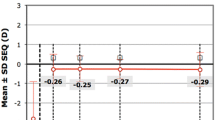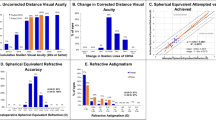Abstract
The purpose of this study was to evaluate the correlation of important risk factors for LASIK retreatment and the retreatment rate. A retrospective cohort study was conducted. Records of patients who underwent LASIK between January 2011 and January 2012 at the Zambrano-Hellion Medical Center, Tec de Monterrey (México), and posteriorly underwent LASIK retreatment were identified and risk factors to receive retreatment were assessed using relative risk. Main outcomes were retreatment rate, risk factors for retreatment, and uncorrected distance visual acuity (UDVA). 482 eyes from 241 patients were available for a 36-month follow-up analysis. 68.5 % had primary myopic LASIK; 37 % were ≤2 diopters (D), 52 % were >2 and <6 D, and 11 % were ≥6 D of myopia. 31.5 % of the eyes had hyperopic LASIK. Retreatment was performed in 6.85 % eyes. Myopia >6 D (RR 4.13), hyperopic refraction (RR 3.18), and age >40 (RR 3.07) were the most important risk factors for retreatment (P = 0.004, P = 0.007, P = 0.006, respectively). UDVA was ≥20/40 in 92.1 % and ≥20/20 in 81.6 % of the retreated eyes and 82 % of the eyes within ±0.50 D of target refraction. Increasing degrees of myopia, followed by hyperopic refraction, and age were the most important associated factors to retreatment. LASIK retreatment was safe and effective.

Similar content being viewed by others
References
Tahzib N, Bootsma S, Eggink F et al (2005) Functional outcomes and patient satisfaction after laser in situ keratomileusis for correction for myopia. J Cataract Refract Surg 31:1943–1951
Garamendi E, Pesudovs K, Elliot D (2005) Changes in quality of life after laser in situ keratomileusis for myopia. J Cataract Refract Surg 31:1537–1543
Jabbur N, Sakatani K, O’Brien T (2004) Survey of complications and recommendations for management in dissatisfied patients seeking a consultation after refractive surgery. J Cataract Refract Surg 30:1867–1874
Zadok D, Maskaleris G, Montes M et al (2000) Hyperopic laser in situ keratomileusis with the Nidek EC-5000 excimer laser. Ophthalmology 107:1132–1137
Yuen LH, Chan WK, Koh J et al (2010) A 10-year prospective audit of LASIK outcomes for myopia in 37,932 eyes at a single institution in Asia. Ophthalmology 117(6):1236–1244
Alió JL, Muftuoglu O, Ortiz D et al (2008) Ten-year follow-up of laser in situ keratomileusis for myopia of up to −10 diopters. Am J Ophthalmol 145(1):46–54
Perez-Santoja JJ, Bellot J, Claramonte P et al (1997) Laser in situ keratomileusis to correct high myopia. J Cataract Refract Surg 23:372–385
Sugar A, Rapuano CJ, Culbertson WW et al (2002) Laser in situ keratomileusis for myopia astigmatism: safety and efficacy: a report by the American Academy of Ophthalmology. Ophthalmology 109:175–187
Knorz MC, Liermann A, Seiberth V et al (1996) Laser in situ keratomileusis to correct myopia of 6.00–29.00 diopter. J Refract Surg 12:575–584
Maldonado-Bas A, Onnis R (1998) Results of laser in situ keratomileusis in different degrees of myopia. Ophthalmology 105:606–611
Randleman JB, White AJ Jr, Lynn MJ et al (2009) Incidence, outcomes, and risk factors for retreatment after wavefront-optimized ablations with PRK and LASIK. J Refract Surg 25:273–276
Alió JL, El Aswad A, Vega-Estrada A et al (2013) Laser in situ keratomileusis for high hyperopia (>5.0 diopters) using optimized aspheric profiles: efficacy and safety. J Cataract Refract Surg 39:519–527
Watson SL, Bunce C, Allan BD (2005) Improved safety in contemporary LASIK. Ophthalmology 112(8):1375–1380
Saeed A, O’Doherty M, O’Doherty J, O’Keefe M (2007) Analysis of the visual and refractive outcome following laser in situ keratomileusis (LASIK) retreatment over a four-year follow-up period. Int Ophthalmol 27(1):23–29
Hersh PS, Fry KL, Bishop DS (2003) Incidence and associations of retreatment after LASIK. Ophthalmology 110:748–754
Febbraro JL, Buzard KA, Friedlander MH (2000) Reoperations after myopic laser in situ keratomileusis. J Cataract Refract Surg 26:41–48
Kashani S, Rajan M, Gartry D (2009) Wavefront-guided retreatment after primary wavefront-guided laser in situ keratomileusis in myopes and hyperopes: long-term follow-up. Am J Ophthalmol 147(3):417–423
McAlinden C, Moore JE (2011) Retreatment of residual refractive errors with flap lift laser in situ keratomileusis. Eur J Ophthalmol 21(1):5–11
Acknowledgments
The authors do not report any funding or grant used in the elaboration of this paper.
Conflict of interest
The authors declare that they have no conflict of interest.
Author information
Authors and Affiliations
Corresponding author
Rights and permissions
About this article
Cite this article
Valdez-García, J.E., Hernandez-Camarena, J.C. & Martínez-Muñoz, R. 3-Year follow-up after Lasik: assessing the risk factors for retreatment. Int Ophthalmol 36, 91–96 (2016). https://doi.org/10.1007/s10792-015-0084-4
Received:
Accepted:
Published:
Issue Date:
DOI: https://doi.org/10.1007/s10792-015-0084-4




